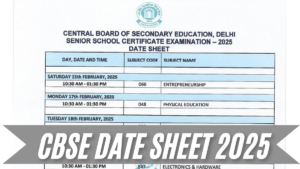UP Board Class 12 Physics Syllabus 2025-26: Are you a Class 12 student studying the subject Physics in the UP Board? Here’s something that may interest you! The Uttar Pradesh Madhyamik Shiksha Parishad (UPMSP) has issued the new syllabus for Class 12 Physics on its official site. The revised syllabus intends to serve as a meaningful focus for students on the most identifiable concepts, chapters, and practicals in advance of the upcoming Board exam.
Physics is one of the most scoring subjects, and yet also a subject that may be found to be a challenge; if you are prepared with the newly revised syllabus for Class 12, it will allow for smart preparation and improved results! In this article, we are providing a visible format of the syllabus that is clear and student-centric for those in Class 12 at possibly a UP Board institution.
UP Board Class 12 Physics Syllabus 2025-26
The UP Board Class 12 Physics exam plays a key role in shaping a student’s academic journey, especially for those interested in science and technology fields. The exam paper will test students’ theoretical knowledge and ability to solve problems. It will consist of 70 marks of theory and 30 marks of practicals. This adds up to the total of 100 marks.
To simplify learning, the UP Board has divided the syllabus into two parts. Part A will have 6 chapters related to mechanics, optics, and modern physics. Part B will comprise 3 chapters divided into electronics and communication system chapters. This division will prepare the students systematically, offering a balance between theory and practicals, which in turn will develop a better performance in their board exam.
Chapter-Wise UPMSP Class 12 Physics Syllabus
Part A
- Electrostatics
- Current Electricity
- Magnetic Effects of Current and Magnetism
- Electromagnetic Induction and Alternating Currents
- Electromagnetic Waves
- Optics
Part B
- Dual Nature of Radiation and Matter
- Atoms and Nuclei
- Electronic Devices
Detailed Class 12th Physics Syllabus for UP Board
The UP Board Class 12 Physics syllabus is designed to give students a clear understanding of important concepts and prepare them well for the exam. The syllabus has a reflection of theory and practical, allowing students to develop problem-solving strengths. The syllabus can be broken down into two parts- Part A, which has 6 chapters covering electricity, magnetism, and optics, and Part B, which has 3 chapters associated with atoms, nuclei, and electronics. By going through the syllabus well, students can strengthen their foundation and get better scores in the examination. As a matter of convenience, students can see the detailed UP Board Class 12 Physics syllabus shown below, chapter-wise.
| Detailed UP Board Class 12th Physics Syllabus 2025-26 | ||
| Part | Chapters | Topics |
| Part A | Electrostatics |
|
| Current Electricity |
|
|
| Magnetic Effects of Current and Magnetism |
|
|
| Electromagnetic Induction and Alternating Currents |
|
|
| Electromagnetic Waves |
|
|
| Optics |
|
|
| Part B | Dual Nature of Radiation and Matter |
|
| Atoms and Nuclei |
|
|
| Electronic Devices |
|
|
UP Board Class 12 Physics Syllabus PDF Download Link
The official link to check and download the newly released UP Board Class 12th Physics Syllabus PDF has been activated at the official website of the Uttar Pradesh Madhyamik Shiksha Parishad, i.e., upsmp.edu.in. The syllabus helps students by giving them a clear roadmap of important topics, ensuring focused preparation, saving time, and building strong concepts. It guides them in practicing the right questions for better exam performance. Students can also check the direct link to download the official UPMSP Class 12 Physics Syllabus PDF below:
Best Preparation Tips for UP Board Class 12 Physics Exam
- Understand the Syllabus First: Go through the official UPMSP syllabus and mark the weightage of each unit. This will help you decide which topics to give more time.
- NCERT is the Base: Most of the board exam questions are directly from NCERT. Read the theory, examples, and in-text questions carefully.
- Practice Numericals:
Focus on important chapters like Current Electricity, Magnetism, Ray & Wave Optics, Electrostatics, and Alternating Current.
Solve at least 5 years of previous question papers for numerical practice.
- Learn Diagrams & Derivations:
Physics exams always include derivations and diagrams like the Lens formula, the Wheatstone Bridge, the Transformer, and the YDSE.
Write step by step for full marks.
- Maintain Formula & Notes Sheet: Prepare a separate sheet with all formulas and important definitions for quick revision.
- Solve Previous Year Papers: This helps in understanding the exam pattern and frequently asked topics.
- Time Management
Practice writing answers within the time limit of 3 hours.
Attempt the theory questions first, then the numericals.
- Revision Strategy
In the last 15 days, revise one unit daily.
In the last week, focus only on formulas, definitions, and diagrams.
- Good Presentation: Keep your handwriting neat, draw clean diagrams, and write steps clearly. This creates a good impression on the examiner.
- Don’t Skip Important Topics: Chapters like Electrostatics, Current Electricity, Magnetism, Optics, and Modern Physics are high-scoring and must not be skipped.










 UPMSP Center List 2026 Released, Check D...
UPMSP Center List 2026 Released, Check D...
 UP Board Class 12 Syllabus 2025-26 Out, ...
UP Board Class 12 Syllabus 2025-26 Out, ...
 CBSE Date Sheet 2025 Out, Download Class...
CBSE Date Sheet 2025 Out, Download Class...







